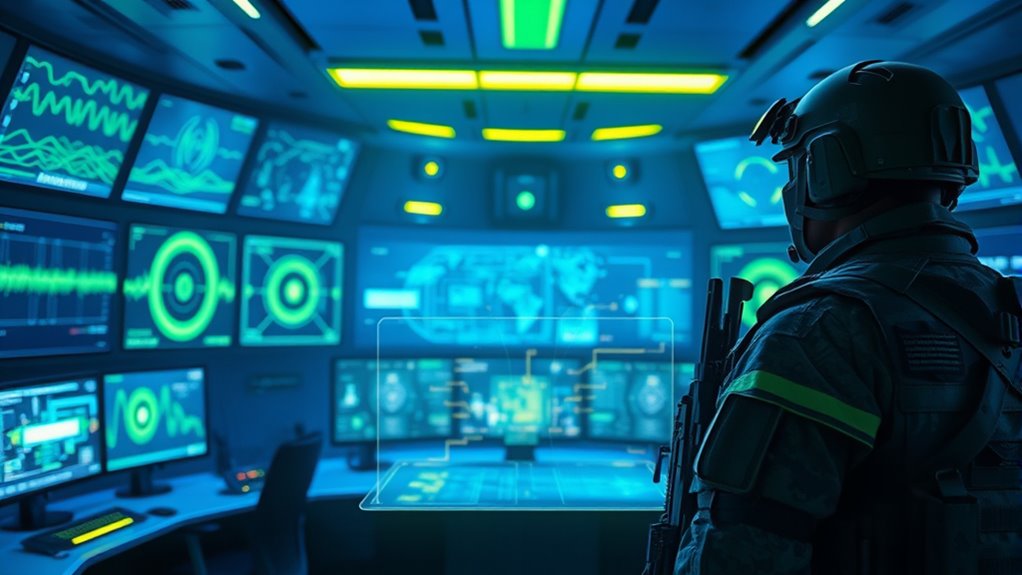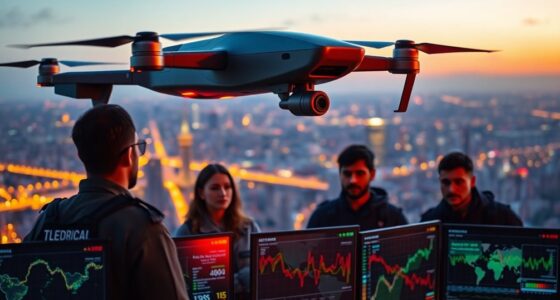Electronic Warfare 2.0 uses AI-enabled signal interception to create an environment where adversaries have nowhere to hide. It adapts in real time, identifying and neutralizing threats automatically, making traditional methods obsolete. Autonomous systems can deceive with cyber deception, while AI analyzes signals to predict enemy actions effectively. This shift makes your electronic environment highly dynamic and unforgiving for opponents. To understand how these advanced tactics reshape modern conflict, explore further insights ahead.
Key Takeaways
- AI-enabled systems dynamically analyze and intercept signals, making traditional hiding methods ineffective in electronic warfare environments.
- Autonomous jamming adaptively neutralize threats in real time, reducing the adversary’s ability to conceal or evade detection.
- Cyber deception techniques create false signals and decoys, misleading enemies and complicating their electronic signature.
- Rapid AI threat prediction enables proactive responses, ensuring no signal goes unnoticed or uncontested.
- The integrated AI-driven electromagnetic environment grants an unbeatable strategic advantage, leaving adversaries with nowhere to hide.

Electronic Warfare 2.0 marks a transformative shift in how militaries detect, disrupt, and defend against digital threats. With advancements in artificial intelligence and machine learning, the battlefield is no longer just about physical assets; it’s about information dominance and cyber resilience. You now face an environment where adversaries leverage autonomous jamming systems that can adapt in real time, making traditional countermeasures obsolete. These systems can identify your signals and automatically deploy interference, effectively blinding your sensors and communications without human intervention. This autonomous jamming isn’t static; it evolves during operations, continuously optimizing its tactics to counteract your strategies. As a result, your ability to rely on conventional jamming or signal suppression techniques diminishes, demanding more sophisticated, AI-driven responses.
Electronic Warfare 2.0 transforms defense with autonomous, adaptive jamming and AI-driven cyber deception for real-time threats.
Cyber deception becomes a critical element in this new landscape. Instead of simply trying to block or disrupt signals, you’re increasingly deploying deceptive tactics that mislead adversaries about your true intentions and capabilities. AI-enabled cyber deception involves creating false targets, fake signals, and decoy systems that appear authentic on enemy sensors. These tactics confuse and delay their decision-making process, giving you a strategic advantage. By integrating cyber deception with autonomous jamming, you can not only disrupt enemy communications but also manipulate their perception of the battlefield, making it harder for them to anticipate your moves. This layered approach makes your electronic warfare efforts more resilient and unpredictable.
You’re also leveraging AI to analyze vast amounts of electronic signals in real time, enabling rapid identification of threats and automatic deployment of countermeasures. The AI algorithms sift through data, distinguishing between friendly and hostile signals, and predict enemy tactics before they fully materialize. This proactive approach transforms electronic warfare from a reactive to a predictive discipline. Autonomous jamming systems, powered by AI, can isolate and neutralize specific threats without delay, maintaining your operational tempo. Additionally, regularly assessing and rotating items ensures your defenses don’t become predictable or compromised. Moreover, integrating self-understanding into your systems can improve their adaptability and resilience in complex electromagnetic environments. Staying informed about emerging electronic threats allows you to anticipate adversary tactics and refine your countermeasures continuously. Meanwhile, cyber deception tactics create a virtual fog of war, where enemies struggle to differentiate real targets from decoys, ultimately increasing their uncertainty and reducing their effectiveness. Furthermore, understanding essential oils for electronic health benefits and their properties can support the well-being of personnel operating in high-stress environments. Recognizing the importance of advanced electronic countermeasure techniques, you can stay ahead in this rapidly evolving domain.
In this new era, your electronic warfare toolkit isn’t just about jamming signals; it’s about creating a dynamic, AI-driven environment where your defenses adapt instantly to emerging threats. Autonomous jamming and cyber deception work together, making it almost impossible for adversaries to hide, track, or understand your true capabilities. As a result, you gain a decisive edge—your communications and sensors are protected by intelligent, adaptive systems that keep your operations secure and your opponents guessing. Electronic Warfare 2.0 isn’t just evolution; it’s a complete overhaul that puts you firmly in control of the electromagnetic spectrum.
Frequently Asked Questions
How Does AI Improve Signal Interception Accuracy?
AI improves signal interception accuracy by enhancing signal analysis and data fusion processes. You can rely on AI to quickly analyze vast amounts of data, identifying patterns and anomalies that might go unnoticed. This enables you to accurately interpret signals from complex environments, making interception more precise. By integrating data from multiple sources, AI provides a holistic view, increasing the likelihood of catching critical signals and strengthening your overall electronic warfare capabilities.
What Are the Ethical Concerns of AI in Electronic Warfare?
You should consider that AI in electronic warfare raises ethical concerns like privacy invasion, as it can access sensitive communications without consent. Autonomous decision making by AI systems might lead to unintended escalation or false targets, risking innocent lives. These issues challenge accountability and transparency, making it vital to develop strict regulations. Balancing technological benefits with ethical responsibilities is essential to prevent misuse and protect civil liberties.
Can Adversaries Develop Countermeasures Against Ai-Enabled Interceptors?
You might wonder if adversaries can develop countermeasure development strategies against AI-enabled interceptors. They can, by employing deception tactics to mislead the AI systems and creating advanced countermeasures that disrupt signal interception. Staying ahead requires continuous innovation and understanding of AI vulnerabilities. However, your adversaries’ efforts could force you to adapt quickly, making electronic warfare a constant game of strategic evolution and countermeasure development.
How Does Electronic Warfare 2.0 Impact Civilian Communications?
You might worry that electronic warfare 2.0 impacts civilian communications by increasing privacy concerns and causing signal disruption. As AI-enabled interceptors become more advanced, they can access private data and interfere with your signals more effectively, making it harder to maintain secure, reliable communication. This evolution means you need stronger protections and awareness, as your personal privacy could be compromised, and your communication channels may face increased vulnerability to disruptions.
What Training Is Required for Operators of Ai-Enabled EW Systems?
Ever wonder what skills you need to operate AI-enabled EW systems effectively? You must develop strong AI proficiency and deep knowledge of signal analysis. Training involves hands-on experience with advanced algorithms, cybersecurity measures, and real-world simulations to stay ahead of evolving threats. Are you prepared to adapt quickly? Continuous learning keeps you sharp, ensuring you can interpret complex signals and leverage AI tools to protect or disrupt communication channels efficiently.
Conclusion
With AI-driven electronic warfare advancing rapidly, you must stay alert to the new battlefield where signals are constantly intercepted and manipulated. As the saying goes, “Forewarned is forearmed,” meaning you need to adapt quickly to these technological shifts. In this new era, there’s nowhere to hide, and your best defense lies in staying informed and agile. Remember, in the digital age, knowledge truly is power—use it to stay one step ahead.









